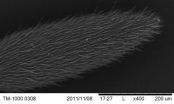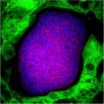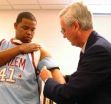(Press-News.org) Ants have four to five times more odor receptors than most other insects, a team of researchers have discovered.
The research team, led by Lawrence Zwiebel at Vanderbilt, recently completed the first full map of olfactory system that provides ants with their sense of taste and smell. They found the industrious insects have genes that make about 400 distinct odorant receptors, special proteins that detect different odors. By comparison, silk moths have 52, fruit flies have 61, mosquitoes range from 74 to 158 and honeybees have 174.
"The most exciting moment for me was when the analysis came back showing that we had identified more than 400 OR genes, the largest number of any known insect species," said Xiaofan Zhou, the research associate who headed up the characterization process. "It meant that we had successfully taken the first step toward gaining a new level of understanding of the complex social system that has made ants one of the most successful families on the planet."
People have long been intrigued and inspired by ants' ability to form highly organized colonies with division of labor, communication between individuals and ability to solve complex problems. For some time, scientists have also known that chemical communication plays an important role in ant behavior. "So it's a reasonable supposition that this dramatic expansion in odor-sensing capability is what allowed ants to develop such a high level of social organization," said Laurence Zwiebel, professor of biological sciences, who directed the new study published in the Aug. 30 issue of the journal PLoS Genetics.
Zwiebel's team characterized the olfactory systems of two distinctly different ant species as part of an interdisciplinary project titled "Epigenetics of Behavior, Longevity and Social Organization in Ants," headed by Danny Reinberg of New York University and funded by the Howard Hughes Medical Institute. In 2010, the project sequenced the genomes of the two species – the Florida carpenter ant (Camponotus floridanus) and the Indian jumping ant (Harpegnathos saltator) – for the first time. This effort set the stage to make the detailed olfactory study possible.
The olfactory system of most insects is centered in their antennae and is broadly made up of three different classes of receptors: odorant receptors (ORs), that identify different aromatic compounds and pheromones; gustatory receptors (GRs), that distinguish between different tastes and react to some pheromones; and newly discovered ionotropic glutamate receptors (IRs), that are narrowly tuned to various poisonous and toxic compounds. The study found that the primary expansion in the ant's olfactory system is focused on ORs. The number of GRs and IRs are comparable to those found in other insects.
The initial automated analysis of the two ant genomes found only about 100 genes for ORs and ten GRs. "We knew these numbers were low because olfactory receptors are very difficult to identify," Zhou said. So he and his colleagues designed a novel automated bioinformatic process for this purpose, combined with extensive manual evaluation.
The researchers also compared both the identity and expression levels of ORs in the two species and found significant differences. This wasn't surprising because the two species were selected to reflect the high level of diversity that exists within the ant family. Carpenter ants live in large colonies with long-lived queens that produce all the fertilized eggs. There are two castes of sterile workers. When the queen dies so does the colony. Jumping ants, by contrast, live in small groups, the difference between the queen and workers is limited, and some workers can mate and lay fertilized eggs. "The differences in receptors are most probably associated with the difference in lifestyles of the two species," Zhou said.
Similarly, their analysis found important differences in the ORs in the antennae of males and females. Overall, they found that the males have only one third the number of ORs that the females express. "The primary role of males is fertilization of eggs, so we assume that the ORs that males express and that females don't are probably tuned to pheromones produced by the queen," Zhou said.
The team also took the initial steps in identifying the chemical signals that set off specific ORs. Research Associate Jesse Slone adapted an assay that the group initially developed for matching ORs with chemical signals in the malaria mosquito. The assay involves inserting the gene for a receptor into frog eggs so that the receptors are expressed on the egg's surface. By wiring the eggs and then exposing them to different chemical compounds, the eggs produce a measurable electric signal when the receptor is activated.
Slone used this assay to identify the compounds that trigger one OR on each of the ant species. He found that an aromatic compound found in anise triggered the OR from the jumping ant that he tested. The receptors were found in both males and workers. Since studies have shown that anise oil has a repellant and/or insecticidal effect on some species of insects, the compound may be a general insect repellent that this OR is designed to detect, Slone speculates.
By comparison, the OR from the carpenter ant turned out to react to a naturally occurring odorant found in cooked beef and pork. The scientists have no idea why this compound is relevant to the ants, but they did establish that the specific receptor is enhanced in workers, relative to males.
"This is just the beginning. But we have demonstrated that we have the basic tools we need to act as 'OR detectives' to map the ants 'odor space' and identify the chemical signals that trigger specific behaviors in the ant's extensive repertoire," Slone said.
This represents the opening of a major new research avenue for the Zwiebel Lab, which has been focused on pioneering work deconstructing the olfactory system of the malaria mosquito. "When I was in graduate school, a group of us dreamed about deciphering the role that genes might play in ant social behavior. So I couldn't pass up this opportunity when it came along. It's taken 30 years but we've finally gotten to the point where we can actually do these studies."
INFORMATION:
Assistant Professor of Biological Sciences Antonis Rokis, Professor Shelley Berger at the University of Pennsylvania, Assistant Professor Jürgen Liebig at Arizona State University, Assistant Professor Anandasankar Ray at the University of California, Riverside and Professor Danny Reinberg at New York University also contributed to the study, which was funded by the Howard Hughes Medical Institute.
Visit Research News @ Vanderbilt for more research news from Vanderbilt.
[Media Note: Vanderbilt has a 24/7 TV and radio studio with a dedicated fiber optic line and ISDN line. Use of the TV studio with Vanderbilt experts is free, except for reserving fiber time.]
Ants have an exceptionally 'hi-def' sense of smell
2012-09-11
ELSE PRESS RELEASES FROM THIS DATE:
Researchers find 2 gene mutations drive adrenal cancer
2012-09-11
This press release is available in Portuguese.
ANN ARBOR, Mich. — Two different genetic mutations cooperate to induce adrenal cancer, according to a new study from researchers at the University of Michigan Comprehensive Cancer Center and University of Sao Paulo in Brazil.
The finding provides new clues to this rare and deadly cancer type, and researchers hope it will lead to better treatments by targeting both mutations.
About 600 Americans are diagnosed with adrenal cancer per year. It is typically diagnosed in late stages when there is nearly no chance of survival ...
CWRU nurse researchers find effort takes its toll on unpaid family caregivers
2012-09-11
According to AARP, the annual cost of unpaid elder caregiving – work that falls mainly on the backs of family members – runs about $450 billion.
While some companies document the physical and emotional toll that the workplace takes on their employees, exactly how draining caregiving might be has never really been measured.
So Case Western Reserve University nurse researchers studied it.
"Without knowing the impact of effort, we have two vulnerable people at risk for health issues—the caregiver and the care receiver," said Evanne Juratovac, assistant professor at ...
'Civilian cyber-warriors' not driven by patriotism
2012-09-11
EAST LANSING, Mich. -- People who commit cyber-attacks against the government also tend to download music illegally and participate in physical protests. Surprisingly, however, they don't appear to be acting out of some sense of national pride or patriotism.
Those are some of the findings to emerge from a Michigan State University study that for the first time begins to paint a profile of "civilian cyber-warriors," or people who engage in attacks against domestic or foreign governments. Cybercrimes pose a huge societal risk and have become a hot issue globally, yet little ...
Study ties forest 'greenness' in western US to snowpack extent
2012-09-11
Results of a new study tie forest "greenness" in the western United States to fluctuating year-to-year snowpack extent.
The results show that mid-elevation mountain ecosystems are the most sensitive to rising temperatures and to changes in precipitation and snowmelt.
University of Colorado-Boulder scientist Noah Molotch and colleagues used satellite images and ground measurements to identify the threshold at which mid-level forests sustained by moisture change to higher-elevation forests sustained by sunlight.
A paper reporting the results was published yesterday ...
NASA catches Tropical Storm Leslie and Hurricane Michael in the Atlantic
2012-09-11
Satellite images from two NASA satellites were combined to create a full picture of Tropical Storm Leslie and Hurricane Michael spinning in the Atlantic Ocean. Imagery from NASA's Aqua and Terra satellites showed Leslie now past Bermuda and Michael in the north central Atlantic, and Leslie is much larger than the smaller, more powerful Michael.
Images of each storm were taken by the Moderate Resolution Imaging Spectroradiometer, or MODIS instrument that flies onboard both the Aqua and Terra satellites. Both satellites captured images of both storms on Sept. 7 and Sept. ...
'Humanized' mice developed at OHSU enable malaria research breakthrough at Seattle BioMed
2012-09-11
PORTLAND, Ore. — A novel human liver-chimeric mouse model developed at Oregon Health & Science University and Yecuris Corporation has made possible a research breakthrough at Seattle Biomedical Research Institute that will greatly accelerate studies of the most lethal forms of human malaria.
The study findings are published online in the Journal of Clinical Investigation. Study photos were selected to appear in "Scientific Show Stoppers" on the JCI blog.
Plasmodium falciparum, one of two human-specific malaria parasites, is a global health crisis, causing more than ...
Mushroom-derived compound lengthens survival in dogs with cancer, Penn Vet study finds
2012-09-11
PHILADELPHIA — Dogs with hemangiosarcoma that were treated with a compound derived from the Coriolus versicolor mushroom had the longest survival times ever reported for dogs with the disease. These promising findings offer hope that the compound may one day offer cancer patients — human and canine alike — a viable alternative or complementary treatment to traditional chemotherapies.
The study was conducted by two University of Pennsylvania School of Veterinary Medicine faculty. Dorothy Cimino Brown is professor and chair of the Department of Clinical Studies and director ...
Psychopathic boldness tied to US presidential success
2012-09-11
The fearless dominance associated with psychopathy may be an important predictor of U.S. presidential performance, suggests an analysis published this week in the Journal of Personality and Social Psychology.
"Certain psychopathic traits may be like a double-edged sword," says lead author Scott Lilienfeld, a psychologist at Emory University. "Fearless dominance, for example, may contribute to reckless criminality and violence, or to skillful leadership in the face of a crisis."
In fact, fearless dominance, linked to diminished social and physical apprehensiveness, ...
LifeSkills training helps teens manage anger, lower blood pressure
2012-09-11
AUGUSTA, Ga. – A 10-week program that fits easily into the high school curriculum could give students a lifetime of less anger and lower blood pressure, researchers report.
Health and physical education teachers taught anger and stress management to 86 ninth graders in Augusta, Ga., and found their ability to control anger increased, their anxiety decreased and their blood pressures were generally lower over the course of a day compared to 73 of their peers who received no intervention, according to a study published in the journal Translational Behavioral Medicine.
Among ...
Measuring mercury levels: Nano-velcro detects water-borne toxic metals
2012-09-11
ANN ARBOR, Mich.—A strip of glass covered in hairy nanoparticles can cheaply and conveniently measure mercury, which attacks the nervous system, and other toxic metals in fluids.
Researchers at the Swiss Federal Institute of Technology (EPFL), Northwestern University and the University of Michigan found that their new method can measure methyl mercury, the most common form of mercury pollution, at unprecedentedly small concentrations. The system, which could test for metal toxins in drinking water and fish, is reported in the current edition of Nature Materials.
Methyl ...






